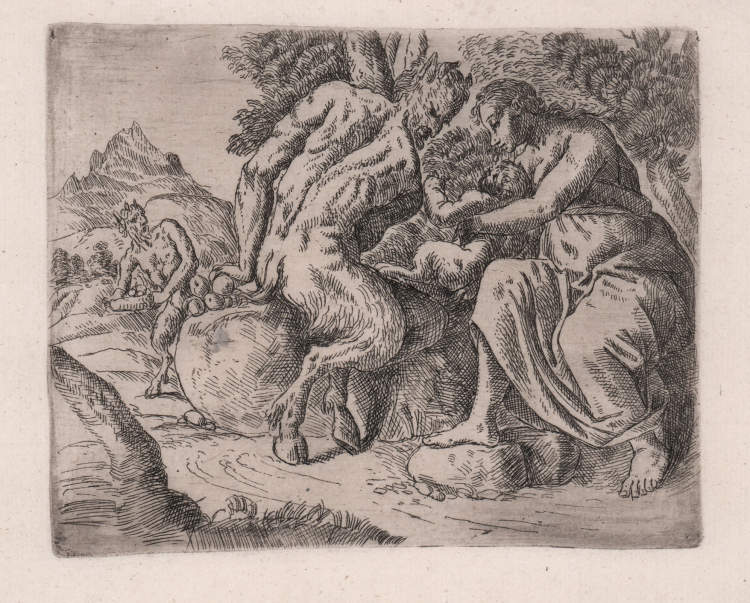




| Reference: | S26718 |
| Author | Marco SAN MARTINO |
| Year: | 1640 ca. |
| Measures: | 145 x 188 mm |



| Reference: | S26718 |
| Author | Marco SAN MARTINO |
| Year: | 1640 ca. |
| Measures: | 145 x 188 mm |
Etching, without date and signature. A magnificent impression, rich in tone, printed on contemporary laid paper without watermark, with wide margins, in good condition.
Marco Sanmartino, San Martino or Sammartino was a Neapolitan painter lived in the second half of the seventeenth century, according to Bartsch active around 1680. Malvasia mentions it under the name of Sanmarchi Veneziano, almost certainly the artist's stay in Venice. Sanmartino the painter known and appreciated especially landscapes with small figures, praised for their respect to the veracity of the sites, wisdom and attention to detail. These qualities become, graphic work, a balanced use of luminance contrast between foreground figures and backdrops with rocks, tree houses and fifth, according to a figurative tradition that Antonio Tempesta was handed down to Filippo di Liagno. The activity of the engraving Sanmartino is placed in a precise historical relationship, formal and stylistic with that of Filippo Napoletano.
Comparatively little is known to date about the life of the painter and etcher Marco San Martino, who was born in or around Naples, and researchers have so far paid little attention to his work. This probably has to do, amongst other things, with the fact that only a few prints of each of his etchings and a mere handful of his paintings have survived. Moreover, the many journeys San Martino undertook through Italy mean that he cannot be assigned to any particular school, while his idiosyncratic etching style makes him something of an odd man out. One of the main characteristics of his prints is that they were evidently produced at great speed and were almost never reworked, as a consequence of which subsequent printing states can only be verified in extremely rare cases. Moreover, many of his works, regardless of whether they show sacred, mythological or genre-like scenes, feature motifs of cattle grazing or peasants. Paolo Bellini points out that the artist was often very ingenious in his compositions and that his modest, artistically unorthodox oeuvre was apparently not intended as a kowtow to the complex art practices of his time but was compiled simply for his own pleasure.
A very rare work; example from the collection F.H. (Lugt 3373).
Bibliografia
Bartsch, Le Peintre graveur, XXI, 16; Alba Costamagna, Incisori Napoletani del’600, p. 165; P. Bellini, TIB / The Illustrated Bartsch (4723.016).
Marco SAN MARTINO (Napoli 1615/25 - Venezia 1680/1700)
|
Italian painter and printmaker (1615/25 probably Naples – 1680/1700 Venice). He remains a little-known painter, but his vivid and spontaneous etchings are highly personal and innovative. After a period in Bologna he went to Venice where he became known as a painter of small landscapes with figures (untraced). These were praised for their realism and effects of light. His few known religious works include St Silvester Baptizing Constantine (Rimini, Mus. Com.) from the church of S Colomba in Rimini and St Vincent Preaching in the Desert (Venice, S Vincenzo). His small etchings, of mythological and sacred subjects, show the realism admired in his landscapes. His effective contrasts between dark foreground figures and light distances, with rocks, cottages and clumps of trees, derive from a tradition that runs from Antonio Tempesta to Filippo Napoletano.
|
Marco SAN MARTINO (Napoli 1615/25 - Venezia 1680/1700)
|
Italian painter and printmaker (1615/25 probably Naples – 1680/1700 Venice). He remains a little-known painter, but his vivid and spontaneous etchings are highly personal and innovative. After a period in Bologna he went to Venice where he became known as a painter of small landscapes with figures (untraced). These were praised for their realism and effects of light. His few known religious works include St Silvester Baptizing Constantine (Rimini, Mus. Com.) from the church of S Colomba in Rimini and St Vincent Preaching in the Desert (Venice, S Vincenzo). His small etchings, of mythological and sacred subjects, show the realism admired in his landscapes. His effective contrasts between dark foreground figures and light distances, with rocks, cottages and clumps of trees, derive from a tradition that runs from Antonio Tempesta to Filippo Napoletano.
|